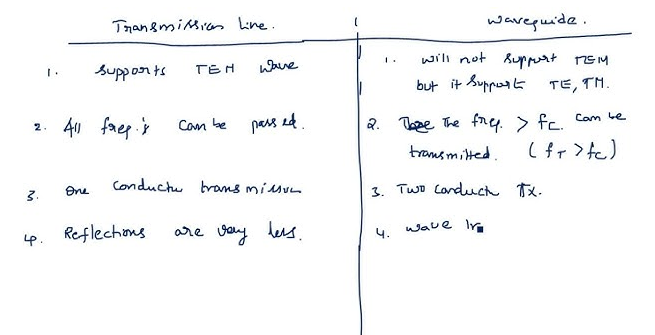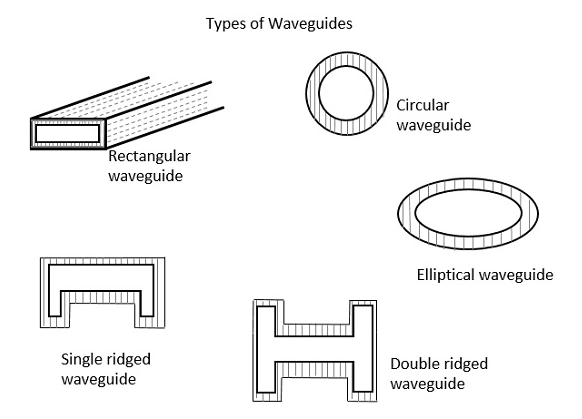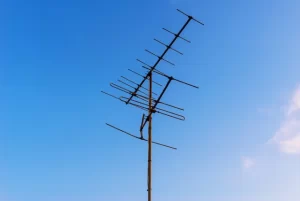Table of Contents
Shape and Mode Support
Rectangular and circular waveguides are so dissimilar in their physical shapes that different manners of supporting various types of electromagnetic waves characterize them. The two flat and two narrower sides of a rectangular waveguide primarily serve the propagation of transverse electric and transverse magnetic – TE and TM, respectively – types of waves. The type of mode propagation most widely frequented in rectangular waveguides is the TE10-type, characteristic of having one half a full cycle of the electric field along the broadest side of the waveguide. A rectangular waveguide in its standard size of WR-90 – sometime appropriate for the X-band part of the spectrum between 8.2 and 12.4 GHz, commonly utilized in radar technology – will exhibit the fundamental mode at frequencies not lower than 6.56 GHz, the device’s “cut-off” frequency.
As for the other type of waveguides, the circular waves, which have a perfectly circular shape, they can support a greater number of TE, TM, and hybrid modes, such as the less popular but still significant HE11 mode. The most widely used mode, however, is TE11. Circular waveguides also have a symmetric flue cross-section to allow for circular patterns of modes and to facilitate circular motions in radar systems. An ordinary circular waveguide with a diameter of 3.1 cm can support its most common TE11 mode at frequencies as low as 5.17 GHz. The difference in modes supported is directly rolled over to various applications.
Rectangular waveguides, with their distinctly known single mode of wave and a greater power that can be transmitted, are more widely used in application where power plays a significant role and in broadcasting and telecommunication systems. The rectangular waveguide’s responses are especially frequent in radar Technology. These applications mostly require the use of waveguides due to their specific need to keep the signals at a certain power level. In contrast, circular waveguides, with the greater flexibility and thus poorer precision-supporting, are more widely applied in aerospace due to the nature of the various operational pressures and temperature waves that a waveguide may be subjected to.
In addition, rectangular waveguides are more widely common and thus less expensive to produce than their counterparts due to the less stringent requirements for equipment such as restricted chambers and greater material cleanness method. The cost of a standard rectangular waveguide can be more than 20% less than that of a circular waveguide of similar properties, so that cheaper waveguides are commonly used in planar structures.

Cut-off Frequency
The cut-off frequency of a waveguide, at which this mode can longer propagate, is very different for rectangular and circular waveguides because of the significant difference between their cross-sectional shapes at the same working frequency. This characteristic heavily influences the difference in their application on the base of frequency. In rectangular waveguides, each mode has a flight cut-off frequency on the base of its specific width and height. For a standard model Wr-90, with the most common cross-section of 2.286 cm by 1.016 cm or ratio 2.25:1, this frequency equals 6.56 GHz for the main working mode TE 10 or the basic mode of operation. In this case, rectangular waveguides are widely used in X-band radar and satellite communication, and the working frequency of the Wr-90 waveguide is 8.2-12.4 GHz.
For the circular waveguide of a similar size to be used in similar applications, the dominant mode will have a lower cut-off frequency. For the TE11 mode, which is the most common, its specific cut-off frequency will be 5.17 GHz for the 3.1 cm diameter waveguide. Thus, it can be equally applied in the radar and telecommunications technology in the same range. At the moment, in microwave communications there is a general tendency to have a broader range and lower frequencies for satellite links.
Thus, the decision to choose a circular waveguide at a lower cut-off frequency makes it cheaper and more convenient and still can be applied in other fields. The choice of the waveguide based on the cut-off frequency also influences the project question, in this case of the radar waveguide installation. For instance, with a lower cut-off frequency, we will need to use a bigger waveguide. In this case, we have higher expenditures at the beginning and utilize fewer on the work. It will be harder to determine which materials can be suitable for bigger waveguides. The company will need to spend more money at the early stages but can expect better performance in various fields throughout the work of the installation.
Power Handling and Loss
Power handling and loss characteristics are significant in determining the application of rectangular and circular waveguides. Structural and material design of the waveguide are attributes that are linked to these factors. Rectangular waveguides are known for their exceptional power handling. This is because they have surfaces that are wider. Their power-handling ability is also advanced since they can dissipate heat more effectively. Radar systems that are used to control air traffic at the 10 GHz ultrahigh frequency range are good examples where rectangular waveguides can operate in power levels of about 1 megawatt peak pulse power.
In the event of high power, these systems are required to prevent signal distortion or system failures. The loss of power is reduced in rectangular waveguides due to the flat surfaces. Conductor losses are diminished since it takes a shorter time for the currents to be conducted. Resistance is reduced, and so is power loss. In contrast, circular waveguides take a longer time hence creating more loss. The result is that power losses increase. A condition can be postulated where circular and rectangular waveguides can be used in the same system. With the same conditions prevailing, it is possible that a circular waveguide can lose more power. The difference is negligible, but it can have an addition of 0.1 dB/m. An example of such a condition can arise in the deployment of microwave relay communication systems which utilize circular guides.
There are also implications in the cost of implementation and operations. Input of material varies because circular guides require that their inner part be machined to create the desired tapper and cross-sectional cut to suit the circular shape. Its weight is not compressed because no part of the structure exists beyond the limits of the structure. The rectangular waveguide that has restricted its dimensions beyond the size of the guide will not require such processes in its manufacture, hence reduced input. The result is that costs are cut to the bare minimum. Nevertheless, when it comes to the mobile radar type in a vehicle, whether this guide can withstand second form bending is not clearly known. The power and losses attributes may at times be less important than the issues of structural strength and flexibility.

Applications
Both, rectangular and circular waveguides find unique applications as their use is directly linked to the physical properties of these guides. The areas where waveguides are used include telecommunications, radar systems, various scientific research, etc.. Depending on the area of use, some of the guides will be more suitable or efficient. Thus, knowledge of these specific areas is essential for selecting an appropriate guide. One of the main uses of rectangular waveguides is in radar and satellite communications.
The main reason is that in these areas it is important to cover high power without significant loss of signal. In the case of the radar system used to for airplanes control and safety, it usually uses X-band or frequencies from 8 to 12 GHz. Thus, the most suitable guide for the system will be the rectangular one that allows covering such powers. The reason is that it can support the dominant mode for the rectangular guide TE10. It practically will allow heating the target the radar is directed at with a beam of microwave energy. This beam unlike parabolic one and some other modes from other types of waveguides tend to scatter in the air much less, concentrating on the target and allowing use of high peak pulse power with a power frequency of 1 MHz.
Circular waveguides can support a number of hybrid modes and are used for guiding circularly polarized waves. Thus the areas of use are the systems that require this type of signal. Examples can be broadcasting antennas, where signal of different types can have significant impact on quality and reliability. Circular waveguides are also used in telecommunications systems where the signal needs to be kept polarized. In addition, it is used at the rotating joints in radar installations. Thus Circular guide shape allows the guide to rotate, but according to one signal does not change its characteristics. For example, radar on aircrafts, ships, etc. where the antenna needs to be directed in various directions as the object moves will use a circular row-waveguide.
Other things being equal, the choice of the guide will influence the system. For example, as cost efficiency here is considered, rectangular waveguides have a number of advantages in it use in satellite communication. The case is in lower manufacturing and signal attenuation costs. For example, the use of a rectangular waveguide can save the company several hundred dollars on each part they manufacture because these parts are cut from simple plates, if a circular guide is selected for this purpose, when the same aluminum plate is used only 33% of it can be used, and the rest is lost as scrap.
What is more important in satellite communication is that the signal attenuation in a waveguide is less than in a coaxial cable. In the case of satellites and frequencies up to infinity, where waveguides are generally used, in the worst case if in the cable this attenuation can be 40 db, in the waveguide, every height db of power loss will be a significant loss in echoes from the satellite.
Circular waveguides are used in the field of Medicine the manufacture of Mein demonstrate devices. The tool helps create a uniform magnetic field for the magnet resonance imaging machine. What is more important is that circular waveguides can support many of their own modes without loss of signal integrity. The mode supports the RF field needed for generator imaging for an accurate picture of the quality of the uniform field.
Manufacturing and Handling
The processes of manufacture and handling of rectangular and circular waveguides result in substantial differences that significantly affect the use of each type in diverse applications in aerospace, telecommunications, and industrial radar systems. A rectangular waveguide is easier and cheaper to manufacture because it can be cut out of a flat metal sheet, whereas a circular one will require more complicated and expensive tooling.
This type’s natural shape adds to its simplicity and ease of manufacture, resulting in reduced time and cost of production. Specifically, for an X-band radar system, a rectangular waveguide can be up to 30% cheaper to produce than an equivalent circle-type waveguide. Rectangular waveguides are, thus, the better option to use when there is a need for quantity due to greater budget constraints which apply to most projects. As there is usually an increase in quality of the product proportionally to the upsurge in cost, rectangular waveguides might be used more often in less sophisticated, lower-quality applications.
It is more difficult and expensive to manufacture a circle-type waveguide because a cross-section of a product is symmetric and must be made accordingly. It would require tooling that can create alterations in all dimensions so that no matter how intricate and complex its outer shape, it is round inside. However, the product itself has a more uniform quality of material structure, as the circular cross-section provides more strength to the waveguide.
A circular waveguide is preferable in situations when it is likely to handle more pressure from external forces, such as in mobile and aerospace applications. The shape helps to withstand vibrations, twists, and bends of the installation and this value is important in order to preserve the signal and provide complete reception. Additionally, there is no need to align the inner surfaces, which can be done at any angle, unlike more certain rectangular waveguides. In the end, the convenience of installation makes the use of a circular waveguide more jam-resistant.







